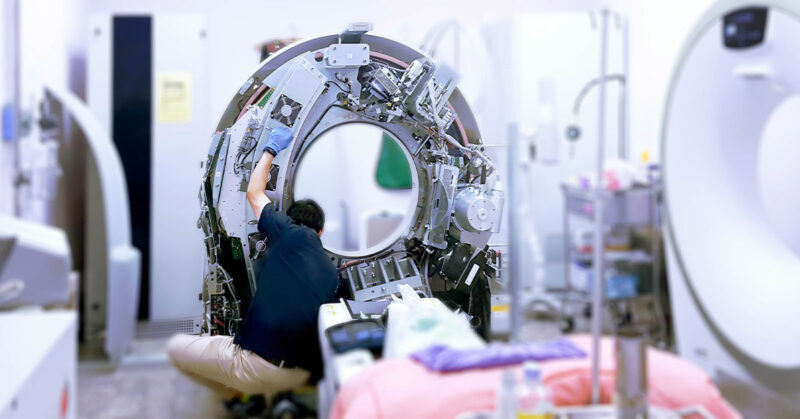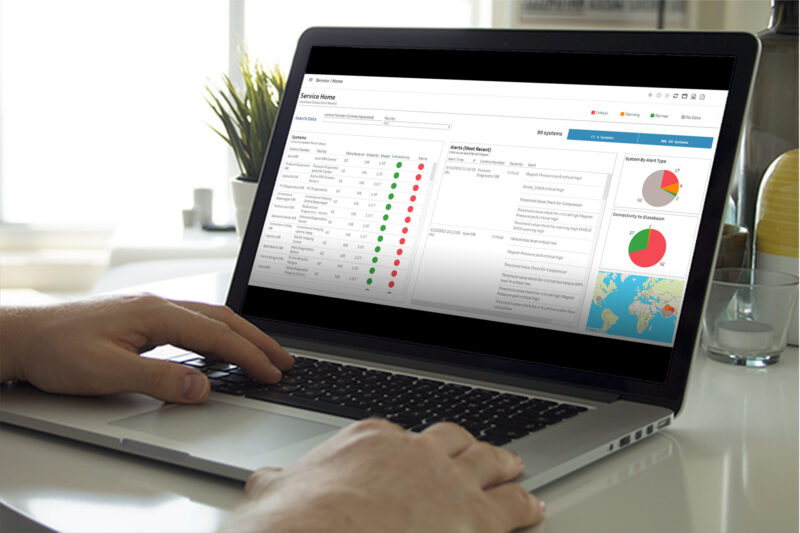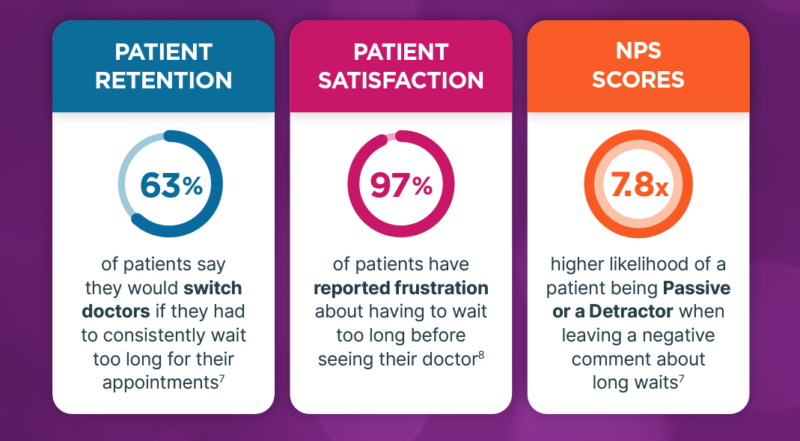
How Disruption Costs Impact Imaging Departments
Medical imaging plays a pivotal role in diagnosing, treating, and monitoring medical conditions. Efficient imaging department operation is crucial to optimize patient care and financial results. One challenge that often goes overlooked is the cost of unplanned disruptions to imaging facility operations. These costs can have a significant and lasting effect on revenue cycle management, patient care, and overall department stability.
This article highlights the importance of tracking disruption costs, the difficulties healthcare organizations face in recapturing the lost revenue, and mitigation tactics to protect your department from unnecessary disruption expenses.
Understanding Disruption Costs
Disruption costs in imaging departments include the financial and operational losses incurred when unplanned downtime disrupts workflow. According to David Mannix, an Imaging Performance Consultant with over 25 years of experience in performance excellence, many factors can contribute to imaging disruption. Mannix says, “Factors such as imaging equipment breakdown, staffing issues, and patient no-shows can all reduce the efficiency of an imaging department. Even challenges with inpatient transport and coordination, or longer required prep time can affect the flow of imaging exams.” Other sources of disruption are outlined below.
Radiology Information System Downtimes
Radiology Information System (RIS) downtimes pose significant risks to imaging centers, particularly for patient data security. The integrity of the Picture Archiving and Communication System (PACS), which stores critical medical images, is a great concern in imaging departments. When unplanned system problems occur, there is a risk of compromising patient records stored in PACS, potentially leading to fines of up to $50,000 for violations of the Health Insurance Portability and Accountability Act (HIPAA) privacy guidelines.
The financial impact of unplanned downtime due to RIS can be significant. For a medium-sized facility with 200 beds, annual revenue losses due to imaging system outages can reach $300,000. This substantial loss can affect a facility’s bottom line and lead to delays in patient care, potentially compromising patient outcomes. Consequently, 32% of radiologists say system continuity and functionality is a top priority, recognizing the critical role of these systems.
The average healthcare facility annually experiences between 2.3 to 7.0 downtime incidents lasting approximately 3.5 hours each. Downtime incidents disrupt workflow, strain resources, increase the risk of data exposure, and diminish financial resources. According to a study by the Ponemon Institute, cost of downtime per minute in an unplanned outage of patient data can reach $17,244. To optimize operations and performance, imaging centers must take steps to prevent and mitigate RIS downtimes.
According to Mannix, proper use of the system is also important. He says, “Staff should upload images into PACS in a timely manner to avoid delay in the radiologist getting results to referring physicians. Following good documentation practices when processing patient records into the RIS and recording the exam start and stop times properly help ensure a quality output. Data integrity is critical.”
Equipment Malfunctions
Equipment failure in radiology refers to the malfunction or downtime of physical imaging equipment such as X-ray machines, MRI scanners, CT scanners, and ultrasound machines. These failures can result from mechanical issues, electrical problems, software bugs, unstable power supply, and so on. Equipment malfunctions can cause disruptions to patient care. As staff work to rectify the issues, the delays can lead to longer wait times for patients.

Mannix says, “Imaging departments are required to do Quality Control checks regularly if they are ACR-credentialled. It’s more about choosing the right maintenance plan for the organization and implementing a strong remediation plan for when there is a service event.”
Radiologist Availability
Imaging departments depend on radiologists to interpret images and provide timely reports for patient diagnoses. Unforeseen circumstances, such as radiologist illness, family emergencies, or scheduling conflicts, can make a radiologist temporarily unavailable. Interruptions in radiologist availability can cause delays in patient care and cause patient anxiety. In addition, delays in radiology reports can strain the workflow of other healthcare professionals who use these reports to make informed decisions about patient treatment plans.
Mannix says, “To avoid radiologist-related downtime, foster a good partnering relationship with your radiologist practice, including visibility to their work schedules and key measures. Make sure they have radiologist-to-radiologist peer reviews to ensure quality reads and manage expectations around study turnaround time. Understand the measurable performance indicators of your partnering radiologist group. Have a forum for problem resolution when things don’t go as planned.”
Diving Deeper into the Hidden Costs of Disruptions
Disruption can cause more than just tangible financial losses and revenue cycle management challenges. Disruptions can also affect intangible costs such as reputation and online reviews, patient satisfaction scores, radiologist satisfaction, and staff satisfaction.
One costly situation is when a patient decides to go elsewhere for imaging services. Along with that lost patient exam is the associated loss of downstream revenue for later follow-up exams. According to Mannix, “Many hospitals don’t have a process to track or recapture lost exams. If an MRI equipment failure causes a canceled day, the hospital may not know if those canceled exams get recaptured. They should know what percent of those exams were recovered. Tracking and follow-up communication is required to get them back on the schedule.”
Mannix adds, “The imaging department employs receptionists, schedulers, patient coordinators, nurses, and technologists. If an imaging machine goes down, some of these team members are unable to work. There will revenue cycle management challenges from the canceled exams, plus the lost opportunity of the staff to work.”
Patient Satisfaction
Disruption within radiology departments can have serious repercussions on patient satisfaction. Delays and appointment cancellations due to unplanned downtime can negatively impact the patient experience. Patients with appointments for diagnostic procedures depend on the timeliness and efficiency of their experience. Studies show that 84% of patients say wait times are crucial to their overall satisfaction.
There is a direct correlation between a patient’s wait time and the doctor’s online rating, affecting the reputation of the physician and imaging center. Discontent is often voiced through negative feedback and online reviews. A staggering 97% of patients report frustration about long wait times to see a provider. Negative ratings can have detrimental effects on an imaging department’s financial performance.
Around 90% of patients use online reviews to evaluate physicians. Imaging centers with negative reviews risk losing patients. One study found that negative online ratings negatively impact doctors’ wellbeing with 78% admitting negative online reviews increase job stress.
Missed Appointments
Missed appointments due to patient frustration with downtime or cancellation can lead to financial losses, with an estimated $200 lost for every open or no-show appointment. This contributes to the staggering $150 billion total cost of missed healthcare appointments in the United States annually.
Mannix says, “If there is an inefficient workflow or poor communication between registration and the scanning technologist, patients may experience long wait times. Patients may get frustrated and leave. Also, patient safety can be impacted if you don’t process and screen properly. Optimal patient care requires standard processes and not skipping steps. Patient safety is always first.”
Delays and cancellations of exams can have a profound impact on patient retention and loyalty. About 1 in 5 patients admits to switching healthcare providers due to prolonged wait times, with 63% saying they would switch doctors if faced with consistent waits.
In terms of revenue, 43% of healthcare organizations report that poor patient retention causes a 10% decrease in revenue. In contrast, U.S. hospitals offering superior patient experiences generate a 50% higher financial performance than their counterparts.
Workflow Interruptions
Workflow disruption is another result of unplanned downtime. According to HIPPA, “When workflows are not properly managed there is potential for mistakes to be made that can have severe consequences.” Unplanned disruptions can have a ripple effect, impacting the entire care team and support staff. When disruptions occur, staff can experience nonproductive periods and sudden surges in workloads once issues are resolved.
A recent study tracked healthcare workers’ verbalized concerns during downtime events. They found that, “Concerns for the workload and workflow during a downtime were almost as prevalent as [the] downtime theme. Discussions related to job roles during downtime (31.4%), followed by the volume of work (22.3%) and concerns over patient safety during downtime (21.5%). The remainder of the discussion was concerned with result reporting (14.8%) and work task interruption from downtime-related sources (10%).”
Erratic workflow can burn out healthcare workers who must constantly adapt to disruptions. About 61% of radiologists have reported symptoms of burnout, with the annual cost of burnout estimated at $4.6 billion in 2023.
Quality of Care
Disruptions can compromise patient quality of care, impacting the organization’s bottom line and market share. Unplanned downtime delays can lead to rushed examinations that result in misdiagnosis, creating a cascade of consequences for patient outcomes.
Patients who do not experience high quality of care are less likely to pay medical bills in full, or even pay them at all. Radiology malpractice lawsuits pose another threat to healthcare organizations. Recent research highlights that the most common cause of medical malpractice suits against radiologists is errors in diagnosis. Errors account for approximately 4% of radiologic interpretations rendered by radiologists. According to the American Medical Association, about 30% of radiologists under 55 have been sued.
Mitigating Disruption Costs
While disruptions and their associated costs are a significant concern, many imaging departments fail to track them, leading to an incomplete understanding of costs and how to prevent them. Mannix says, “Lack of insight into disruption costs makes it difficult to improve. That means having a concise and understandable set of performance metrics. It’s all about continuously working on sustaining a safe and compliant imaging department. It’s not just about recapturing patients. The strategy must include senior leadership support that says, ‘We’re going to focus on making this better.’”
According to Mannix, “Basics such as proper communication, teamwork, organization, and systems are critical to streamlining operations. Leveraging the features of the EMR instead of reliance on paper records makes a big difference. The automation in digital systems can improve efficiency and help to avoid bottlenecks.”
To mitigate disruption costs effectively, healthcare organizations must implement proactive measures. Here are some strategies to consider:
Regular Maintenance and Upkeep
Analyze your preventive maintenance approach and adjust as necessary to best meet your individual organization’s needs. Standards such as AAMI suggest there are three forms of maintenance to consider at various price points and uptime needs:
- Preventive maintenance: The OEM measures, checks and fixes issues before they fail.
- Predictive maintenance: Use predictive analytics to understand the average failure time based on data for each component, and replace them before they are due to fail.
- Run-to-failure: For components that don’t threaten safety, let them run until failure and then replace or repair.
Evaluating your downtime is a critical component in making decisions about maintenance strategy.
Disruption Reports

Service Event Response Plans
A study conducted by The Joint Department of Medical Imaging on managing radiology system downtimes concluded, “Individual workflows and plans with little transparency between teams results in inefficient and error-prone planning and execution of events.” The study states, “In situations where regular downtimes are needed, having the appropriate planning and focus can ensure that patient care is not compromised.”
Imaging departments should develop comprehensive service event plans to address disruptions promptly and minimize the impact on patient care. A designated response team should direct the staff during unplanned downtime events. Clear communication procedures should be followed to ensure staff are aware of the downtime event, how long it will likely last, and how it may impact operations. Be sure to test your plan and improve it over time.
Resource Allocation
Allocate resources thoughtfully, including clinicians, equipment, and budget, to address the areas prone to disruption as illuminated by regular disruption reports. Be prepared with backup options for unforeseen personnel needs.
Patient Communication
Implement effective communication protocols to keep patients informed about changes to their scheduled examinations to improve transparency and manage expectations. With effective communication, patients may be more understanding, minimizing patient dissatisfaction.
Orderly Work Environment
Other workflow elements that are not always considered, according to Mannix, include an orderly work environment. Mannix says, “It’s important that staff have a discipline of proper housekeeping to ensure everything they need has a place in the department, where and when it is needed. Medical supplies should be stocked, and accessories and ancillary equipment should be functional and ready for patient use, following proper disinfection between patients and at the end of the service day. It’s all part of proper scan-room preparation.”
Scheduling and Patient Communications
Only 49% of healthcare organizations have changed their processes to improve patient wait times. More sophisticated scheduling can optimize resource utilization and reduce appointment displacement, improving patient satisfaction.
Mannix says, “Consider starting a daily team huddle with an all-hands review at the start of each service day. Discuss the scan volume goals for the day for each modality. Review the patient schedule. Call out and verify each exam time slot and discuss needs for in-patients, sedation, radiopharmaceuticals and contrast agents. Ensure good patient communication prior to the exam. Do everything you can to make sure it’s a successful exam, including follow-up communication to get the patient back on the schedule if the appointment doesn’t go as planned.”
Conclusion
Disruption costs due to unplanned downtime can encompass a broad range of tangible and intangible costs. The difficulty in recapturing lost revenue during regular hours exemplifies the complexities in managing disruption costs. To optimize uptime and patient quality of care, healthcare organizations should monitor disruption costs by regularly reviewing disruption reports, and adopt maintenance programs and operational processes that prioritize both patient-centered care and revenue retention.
For more information about reducing cost and improving efficiency, read our article about radiology equipment maintenance.
Explore the Possibilities
With more than 1 million exams examined each day by Glassbeam solutions, see how top organizations are transforming their log data into impactful insights.
Transform Your Healthcare Operations
See how to gain deeper, clearer insight from your machine data to elevate business intelligence and to improve your operational uptime, utilization, and efficiency.

